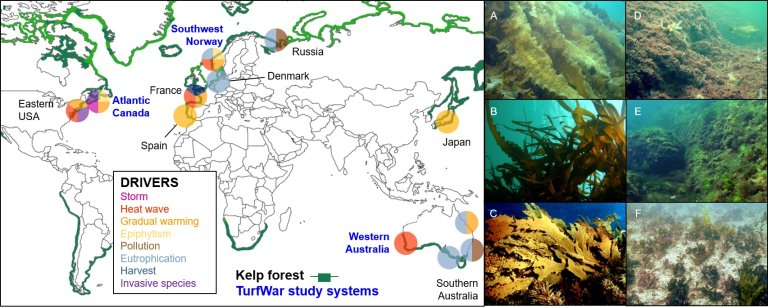
Turf Wars: The New Battle Front of Globally Declining Kelp Forests
In the last decade, there has been an accelerating loss of kelp forests globally, and an associated rise of degraded reefs covered by sediment-laden algal ‘turfs’. During an extreme marine heatwave along the West coast of Australia five years ago, 100 km width of kelp forest collapsed and was replaced by turf algae within two years. In a warming hotspot along the East coast of Canada 89 % of the kelp forests has been lost since 1982, and along the Norwegian coast towards Skagerrak 80 % of the kelp has disappeared since 2002. In both cases, the disappearance of kelp is associated with the appearance of turf algae. In contrast to the desert-like, bare rock seascape that sea urchins leave behind, where kelp can easily reestablish if the sea urchins are removed, it seems like there are mechanisms in the turf algae ecosystem that protects from reestablishment. The global increase in these sudden transformations of ecosystems and loss of habitats is bad news for the marine ecosystems of the world.

Global flattening of kelp forests
Turf algae are a genetically diverse group of macroalgae, but they have some common features: they are made of densely packed branches and small filaments that grow fast, and cover the sea floor like a carpet. Turf-covered reefs are totally lacking the three-dimensional structure of a kelp forest, where an immense richness of crustaceans, fish and snails live and hide. Kelp forests also attain some of the highest rates of primary production of any natural ecosystem on Earth, similar to tropical rainforests. These underwater forests occur across 25% of all coasts globally, and they provide ecosystem services valued at 800 Euro per km. These include habitat for fisheries species, food for marine creatures, protection from waves, harvesting, and storing carbon, all of which will be lost when the kelp forests disappear in favor of the turf algae.
Heat is only one of many threats
It is not higher temperatures alone that causes the kelp forest loss. In a newly published review article, researcher Karen Filbee-Dexter at The Norwegian Institute of Water Research (NIVA) sums up our current knowledge on the topic in collaboration with Professor Thomas Wernberg from The University of Western Australia’s Oceans Institute. Filbee-Dexter explains that the kelp usually disappears long before temperatures exceed the kelp´s physiological tolerance.
- Kelp species thrive in cold water, and their general health is reduced under warmer conditions. This makes them less resilient towards additional stressors like eutrophication, pollution, foreign species, harvest and extreme weather events, Filbee-Dexter says.
Hence, climate change is both directly and indirectly causing the kelp mortality. In addition to gradual changes in temperature, environment and biological interactions that trigger slow loss of kelp over time, sudden weather events like heat waves can knock out a kelp forest in only one summer, which was the case in Australia.
Tipping point towards a new ecosystem
When kelp forests are replaced by turf algae, new mechanisms are established in the turf algae ecosystem that may counteract any reestablishment of the old ecosystem. The substrate is occupied by turf algae, and any free space is covered by sediments which prevent the kelp from proper attachment to the rock. Moreover, kelps are dependent on high kelp densities for a successful reproduction, so a reduction in kelps may limit available kelp to ‘seed’ turf reefs.
If environmental changes were reversed, kelp forests might be able to reestablish. But the first tipping point to the turf state seems to occur at another point than the threshold required to recover the system, meaning that the environmental conditions need to be dramatically improved to restore the system. In biology, this is called hysteresis.
- It has great implications for the management if the shift from kelp forest to turf algae is an example of hysteresis. The management options may be severely limited if the ecosystem is locked into the degraded turf algae state, says Filbee-Dexter.
Successful kelp restoration in Sydney
There is still a need for more knowledge about the direct causes of the kelp mortality across the world´s oceans, so that the right measures can be taken, based on the local conditions and challenges. In Sydney, it was discovered that the poor sewage treatment was the cause of kelp loss in favor of turf algae in the harbor. The sewage treatment plant was upgraded and new, healthy kelp plants were transplanted onto the turfs - and the kelp forest managed to reestablish. There is also work in Norway to develop ‘green gravel’ to seed reefs with young kelps that can re-establish on turfs.
It is, however, the unavoidable, global changes in temperature and extreme weather events that are overwhelming the intrinsic capacity of kelps to adapt and survive in parts of their range and are the biggest and most challenging threats. These changes are often too strong for local management plan to cope with, so it is likely that more and more kelp forests around the world will cross these tipping points. Researchers are exploring innovative solutions to combat these events, but we have a limited window of opportunity to come up with strategies to combat ongoing loss of marine habitats globally.